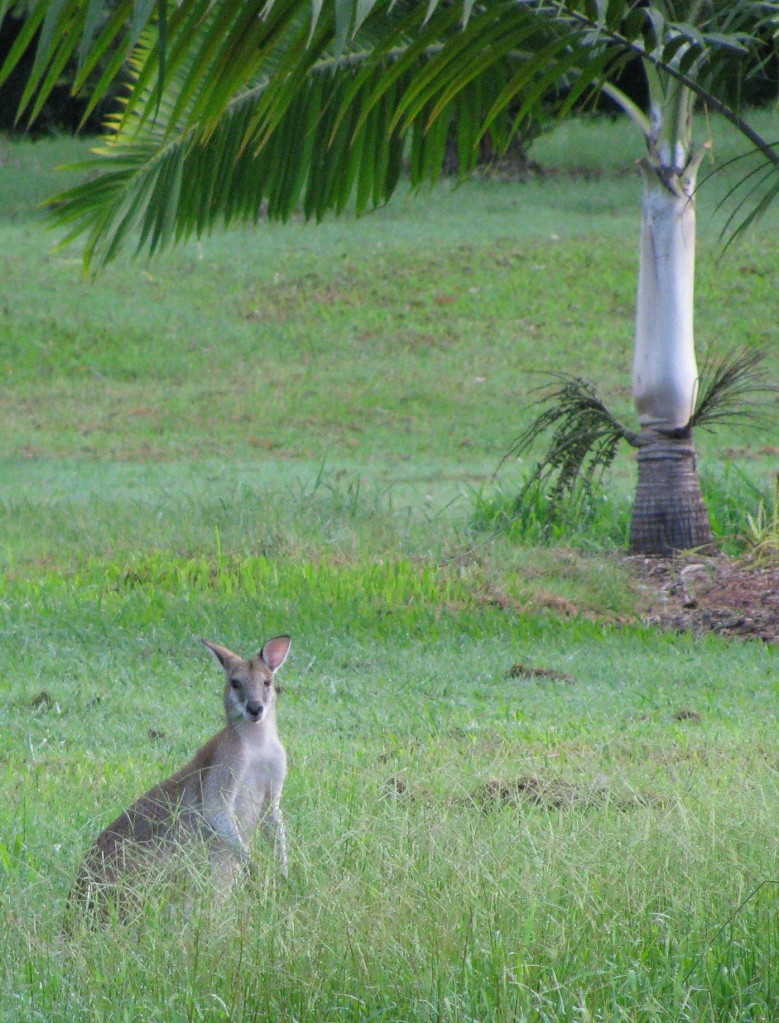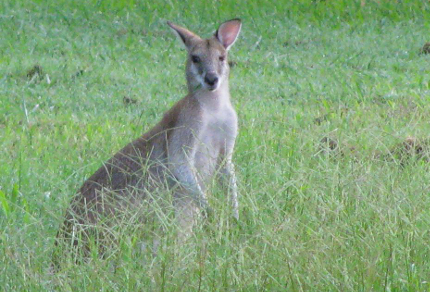
Agile Wallaby (© Magi Nams)
There was something about this morning’s fresh autumn air made me want to ride hard, to explore places I’d never been. To that end, I cycled into the Ross River Parkway and headed for Pioneer Park, which I hoped was another of Townsville’s gracious, bird- and butterfly-friendly spaces. I sped past Aplin’s Weir and Nathan Street bridge, then braked to enjoy the sight of eight agile wallabies grazing and resting in a mowed meadow, their warm reddish-brown fur and pale face stripes lit by morning sun. Noticing me, a large wallaby sat up on its haunches and stared, its ears cupped and swivelling. That alert posture reminded me so much of the white-tailed deer that frequent the meadows beyond my yard in Nova Scotia.
Not wanting to disturb the wallabies, I continued on, cycling past the lopsided ‘V’ of Gleeson’s Weir, past Black Weir with its footbridge I have yet to trod, and into my destination. To my surprise, Pioneer Park was a groomed outdoor recreational space. The grounds enclosed a huge, open air sports stadium, swimming complex, barbecue facilities and picnic tables, as well as playgrounds, playing fields, and an arts centre. Impressed, but somewhat disappointed, I pedalled on, riding toward Ross River Dam until, 15 kilometres from home, the path became no more than a bumpy sidewalk between houses and a main traffic artery.
Retracing my path, I paused in Pioneer Park to chat with a security guard at the swimming complex, which consists of an upper and lower pool, as well as a kiddies’ pool. She informed me that, amazingly, the pools are available free to the public from dawn to dusk (later in summer) all year round. Once again, Townsville scored a direct hit on my approval button for providing facilities to encourage residents of any age and economic status to be physically active.
The wallabies had departed from their meadow, but I thought of them and their larger and smaller macropod cousins as I rode. The arrival of humans to the continent of Australia at least 40,000 years ago placed unprecedented hunting pressure on macropods and other large marsupial mammals.1 Humans also changed the environment through manipulating vegetation by the use of fire.2 Four thousand years ago, Aboriginals introduced dingoes.3 Two hundred years ago, Europeans opened a Pandora’s box of introduced species, including dogs, cats, foxes, and livestock – a number of species of which have since become feral.4 Only last weekend in Girringun National Park, we bushwalked a portion of one of Australia’s Great Walks in the company of a feral cow and calf and spotted sign of feral pigs beside Stoney Creek.
How have all these changes affected macropods? Some became extinct, notably several very large species that were hunted into biological history by Aboriginals long before Europeans ever set foot in Australia.5 Since the arrival of Europeans, macropods have suffered mixed fates. The toolache became extinct, and several species, such as the quokka, parma wallaby, and yellow-footed wallaby are rare or endangered.6
The large kangaroos, one of which is the red kangaroo, may actually have benefited from the clearing of forests and subsequent increase in grazing land and water supplies provided courtesy of European settlers and modern graziers.7 The populations of some species of these larger kangaroos have increased to the point where they have become pests and are now hunted by commercial harvesters.8
On the other hand, smaller macropods inhabiting forests and woodlands have suffered decreases in population levels due to loss of habitat, as well as competition from introduced grazers and browsers like the rabbit, goat, and sheep, plus predation by foxes and cats.9 Effectively, they’ve taken three hard hits, and some are staggering. Lumholtz’s tree kangaroo, which I so wanted to see while we explored rainforests on the Atherton Tablelands, disappeared from the lowlands between Cairns and Innisfail when the rainforests were cleared to create land for developments and all those banana and sugarcane plantations. They can now be found only in mountain rainforests between Cardwell and Mossman.10
Thus, the arrival of humans to Australia has proven to be a boon to some macropods and a devastating plague to others. The agile wallabies, with their graceful, deer-like faces, seem to have adapted fairly well to human presence, taking advantage of green spaces within the city. In that respect, they resemble some of Townsville’s human residents; in particular, a trio of temporarily transplanted Canadians.
1. Chris Johnson. Australia’s Mammal Extinctions: A 50 000 year history. 2006. Cambridge University Press, Cambridge. p. 61, 112-14; 2. Ibid, p. 146-149; 3. Ibid, p. 168.
4. Ronald Strahan, editor. The Mammals of Australia. 1995. Reed New Holland, Sydney. p. 305.
5. Johnson, p. 112-114.
6. Strahan, p. 305; Peter Menkhorst and Frank Knight. A Field Guide to the Mammals of Australia. 2004. Oxford University Press, Melbourne. pp. 116, 126, 132.
7. Strahan, p. 305.
8. John Kelly. Kangaroo Industry Association of Australia. 2008. Accessed 20-Apr-2010. http://www.kangaroo-industry.asn.au/industry.html
9. Strahan, p. 305.
10. Menkhorst and Knight, p. 110.


